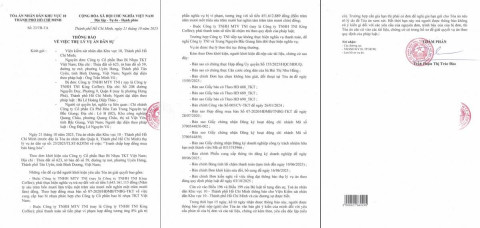How are bank bond interest rates attractive to investors?
- 204
- Business
- 17:04 19/07/2024
DNHN - Bank bonds are attracting investor interest due to their attractive interest rates and high level of security. This is a popular choice among investors in stable and safe financial products today.
Benefits of bank bonds
One of the main attractions of bank bonds is the higher interest rates compared to many other types of investments. The banking sector often has the ability to provide stable and attractive interest rates for bonds due to the stability and high creditworthiness of this sector. High interest rates help investors increase their income from monthly or annual interest and create an attraction in investing in bank bonds.
The banking sector is considered a highly secure industry. With strict control from regulatory agencies and the stability of the banking system, the risk of investing in bank bonds is often considered lower than some other types of investments. This attracts investors who want to protect their capital and seek stability in investment returns.
Bank bonds often have flexible maturities, ranging from a few months to several years. This allows investors flexibility in choosing investment times and creating a diversified investment fund with bonds of different terms. This flexibility helps investors adjust their investment strategy and take advantage of opportunities in the financial market.

For example, Agribank has announced a public bond issuance plan with an interest rate based on the average 12-month VND deposit interest rate at four major banks (Agribank, BIDV, Vietcombank, VietinBank), plus a margin of 2.0%/year. Currently, the 12-month deposit interest rate of these banks ranges from 4.6% to 4.7%/year. With a margin of 2%, Agribank's bond interest rate will range from 6.6% to 6.7%/year, significantly higher than the current long-term deposit interest rate of the group of banks, which is 4.8%/year for a term of 24-36 months.
Agribank's bonds have a 10-year term, and in the last 5 years before maturity, if not repurchased under the right, the bond interest margin will increase to 3.0%/year. In particular, the bonds can be deposited for trading, transfer, or pledge transactions in the investor's securities account.
Holders of Agribank bonds can use them as collateral to borrow from Agribank at an attractive interest rate or use them as collateral to borrow from other banks, depending on each bank's policy.
Agribank plans to issue a total of VND 10,000 billion of these bonds to increase equity capital and expand long-term capital sources to meet lending needs and promote economic development.
Among joint-stock banks, HDBank has carried out a second bond issuance, with an interest calculation based on the average 12-month deposit interest rate of four state-owned commercial banks, plus 2.8%/year. This is a non-convertible bond, without warrants, unsecured, and ranked as subordinated debt, meeting the conditions to be included in HDBank's tier 2 capital.
Investors need to consider and evaluate the bank's creditworthiness
According to statistics from the Ministry of Finance, in the first 6 months of 2024, the total value of privately issued corporate bonds was VND 110,200 billion, of which financial institutions accounted for 63.2% of the total, with VND 69,600 billion. The investor structure shows that financial institutions accounted for 94.8%, including credit institutions accounting for 53.5% and securities companies accounting for 21.9%. Individual investors accounted for about 5.2%. The Ministry also pointed out that the average interest rate of the issuances was 7.41%/year, and the average term was 3.78 years.

According to Dr. Vo Dai Luoc, former Director of the Institute of World Economics and Politics, compared to other industries, bank bonds have a relatively high level of safety. Banks issuing long-term bonds from 3 to 5 years on the market with interest rates ranging from 5% to 6% show that they are maintaining a stable interest rate level in the long term.
Although bank bonds have attractive advantages, investors need to note some factors. Accordingly, although bank bond interest rates tend to be higher, investors need to be aware of interest rate risks. If general market interest rates rise, the value of bonds may decrease, affecting the investor's investment value before maturity. Therefore, capturing interest rate trends and carefully considering before investing is necessary.
Economic conditions and monetary policy can affect the interest rates and security of bank bonds. Investors need to monitor economic indicators and information related to monetary policy to assess the risks and potential returns of investing in bank bonds.
Additionally, when investing in bank bonds, investors need to consider and evaluate the creditworthiness of the bond-issuing bank. This includes researching the financial health of the bank, assessing the level of risk and the bank's ability to pay interest.
Therefore, bank bonds are attracting investors due to their attractive interest rates, security, and flexible maturity times. However, investors need to be aware of interest rate risks, economic conditions, and monetary policy, as well as evaluate the creditworthiness of the bank before investing in bank bonds. Capturing information and careful consideration will help investors make smart and effective investment decisions.
Nghe Nhan
Related news
#bond market

Corporate bond fundraising faces numerous challenges
The corporate bond market is emerging as a vital capital-raising channel, particularly with the rise of large enterprises.

Billionaire Trần Bá Dương’s Thaco raised 1.3 trillion VND in bonds
Thaco has successfully issued a 1.3 trillion VND real estate-backed bond, continuing its strategy of raising large amounts of capital, bringing its total bond liabilities to 13.68 trillion VND.

Real estate bonds shackled by rules
Although experts believe that rating agencies are an indispensable element of a healthy and transparent market, and a significant fundraising channel, real estate developers may suffer hurdles due to stringent bond issuance rules.
Đọc thêm Business
From New Year messages of World Leaders to the “new rules” of the Global economy in 2026
At a pivotal moment of transition, New Year messages from capitals such as Hanoi, Beijing, Washington and Paris reflect distinct priorities and strategic visions.
Connecting Leaders, Shaping the Future: Strategic Leadership Planning Meeting – CorporateConnections Hanoi A
"Your network is your most powerful flowing asset. It generates value, multiplies opportunities, and accelerates your influence across borders."
Innovative ESG enterprise: Trạm Xe Việt startup proposes solutions to build a green mobility ecosystem
As Vietnam commits to achieving Net Zero by 2050 and tightens emissions standards, the transportation sector faces unprecedented pressure to transform.
Deputy Prime Minister Nguyễn Chí Dũng: “The country’s major challenges weigh heavily on my mind — and we must resolve them together.
On the morning of November 26, 2025, Deputy Prime Minister Nguyễn Chí Dũng chaired a high-level working session at the National Innovation Center (NIC) in Hòa Lạc.
Unitsky String Technologies signs cooperation agreements with three Vietnamese partners, opening a new direction for smart mobility and sustainable development
The signing ceremony took place in Minsk, Belarus, on November 28, 2025.
Before the D‑day to abolish flat‑rate tax: Fear of technology and costs leave small traders struggling to adapt
From 1 January 2026 the flat‑rate tax regime will be abolished. Small business households will be required to declare tax based on actual revenue. MISA supports the transition with technology to help micro‑merchants adapt smoothly and transparently.
Vietnamese enterprises at a crossroads: the impact of a potential US–China deal
As the world closely monitors every shift in US-China relations, emerging signals of a strategic agreement between the two global powers are raising hopes for global economic stability.
HDBank: Impressive profit growth, leading in profitability and advancing international integration
Ho Chi Minh City Development Joint Stock Commercial Bank (HDBank, stock code HDB) announced its consolidated profit before tax for the first 9 months of 2025 reached VND 14,803 billion, marking a 17% increase year-on-year (YoY).
TNI King Coffee sued for over VND 5 Billion in unpaid debts
On October 21, 2025, the People’s Court of District 10 in Ho Chi Minh City officially accepted a civil lawsuit concerning a commercial contract dispute between TKT Vietnam Plastic Packaging Joint Stock Company and TNI King Coffee Co., Ltd.
VINASME and Jeonnam Technopark Sign MOU on technology cooperation, human resource training, and trade promotion
On October 15, 2025, in Hanoi, VINASME and Jeonnam Technopark (Korea) signed an MOU to promote trade, advance technology transfer, and develop human resources between enterprises of both nations.











